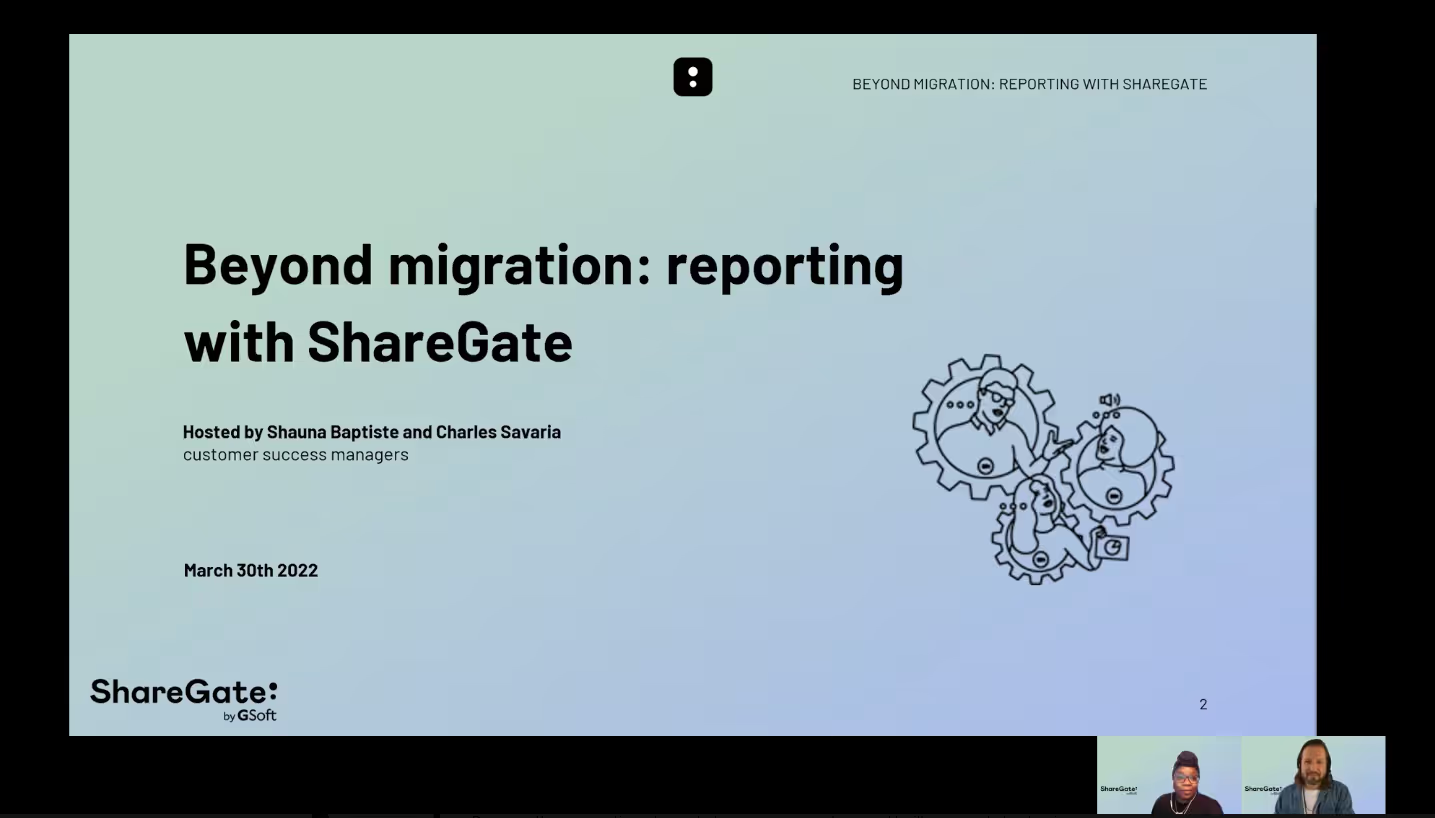ShareGate reports that will change the way you manage Microsoft 365

Table of contents
At ShareGate, we know that reporting is key to keeping your environment on track. Here are some of the most popular reports our customers are using to make the most out of Microsoft 365.
As a (potentially self-proclaimed) master of your SharePoint environment, you’ve got a lot on your plate. Having to oversee the day-to-day operations of users across your organization while maintaining security and efficiency is no easy task, and we don’t think you should have to do it alone. Enter: ShareGate reporting.
You probably already know all about the handy reporting features that are available to you, and how to use them to maximize efficiency and keep things secure across your organization. Just in case, we decided to write a little something to keep you up to date and make sure you’re getting the most out of your Microsoft 365 usage, as well as your ShareGate subscription.
Used properly, reports can provide you with crucial information to plan a migration or manage your SharePoint environment.
To help guide you along the process, we took a deep dive into our user data to provide you with a list of the reports that our clients rely on to give them the information they need to help them manage SharePoint on the day-to-day, as well as prepare for bigger challenges like SharePoint migrations.
To sample ShareGate’s reporting features in action check out this webinar

Custom reports
The ShareGate migration tool provides a number of useful built-in reports to get you the information you need to effectively manage your SharePoint environment.
Most of these reports are also customizable and can be tailored to match the specific business needs of your organization. Alternatively, you can create a report from scratch to get only the information that’s relevant to you.
In the report settings screen, you can select the Object type you want to report on. For example, you can report on teams, sites, OneDrive for Business, and more.
You can then apply filters to find specific objects and add columns that provide you with more information on these objects.
- Object type: Click on the Object type dropdown to select the object types you want to report on. Once selected, you will get access to filters and columns specific to that object type.
- Filters: Filters are used to pinpoint specific objects of the object type you are reporting on. For example, you can use a Site template filter on the object type Site to find all your team sites. Check out all the filters available to you with your ShareGate subscription.
- Columns: Columns can be added to your report to provide you with more information about the objects in your report. For example, you can add the Guests column to a report on the Microsoft Teams object type to get a list of all the guests of each one of your teams.
Check out our detailed documentation to learn more about creating custom reports in ShareGate.
Checked out documents report
The check in/check out feature of SharePoint is one that is frequently misunderstood.
The basic premise behind this feature, should you choose to use it, is that you can reserve a document for editing, so that you can be sure you are the only one who has access to it. Once you’ve made your edits, you can once again check in the document so that it is available to all users across your organization.
"I’m a big fan of ShareGate’s reporting that allows for better control and central management of our environment.”
Nina Klaustrap, SharePoint Specialist at Jn Data
The main issue with checking out documents is that people are forgetful. After all, who amongst us hasn’t put off returning that long-overdue library book? So basically, people forget what they’ve checked out, which inevitably leads to forgetting to check it back in.
The ShareGate migration tool can crawl through your selected target to list all your checked-out documents, and shows you what documents are checked out. Once the report is finished running, you can use the information to guide your decision-making around these documents.
You also have the option to check in all of your checked-out documents directly from the results screen, saving you from having to follow up on each document individually.
Site collection report
The ShareGate migration tool can crawl through your selected target to list all your site collections. You can take action on these site collections once the report is finished running.
Running a site collection report provides you with data on your selected site collection, including:
- Date created
- Last modified date
- Number of subsites
- Site owners
- Administrators
Basically, everything you need to make important decisions around that site collection. When in doubt, you can always contact the site owner for more information.
Orphaned user report
The ShareGate migration tool can crawl through your selected target to list all your orphaned users. You can take action on these users once the report is finished running.
An orphaned user is a user account still referenced by SharePoint even though the user cannot access SharePoint anymore.When you disable or delete a user from your Active Directory (AD), that user's permissions and references in metadata fields such as Created by and Modified by do not get removed in SharePoint or Microsoft 365, and that user becomes an orphaned user.
Wondering when to run these reports? Check out our related article on SharePoint reports to schedule regularly for everything you need.
Unused site report
The ShareGate migration tool determines that a site is unused when it has not been modified in the past 6 months.
To determine the last modified date of a site, the ShareGate migration tool uses the latest date from the following:
- Creation date of the site
- Creation date of a list in the site
- Last modified date of an item from a list in the site
- Last date an item was deleted from a list in the site
From here, you can take action to clean up your unused sites, reducing sprawl in your environment and mitigating the risk of your sensitive data falling into the wrong hands!
If you’ve fallen behind on reporting, hopefully, this article has inspired you to get organized and create a system that works for you. Remember, reporting is key to maintaining an efficient and organized environment that will facilitate communication and collaboration across your organization.
You can schedule your ShareGate reports to run at a time that’s convenient for you. This way, you’ll minimize the disruption to your business operations while still keeping tabs on what’s going on in your environment.
External user report
Allowing your users to collaborate with people outside of your organization can bring a lot of value to your business. It can also be a dangerous undertaking if not carried out properly.
Depending on how your SharePoint sharing settings are configured, guest users in Teams likely have access to their team’s shared documents. So reviewing a list of your guest users can help give you some idea of what’s been shared with whom.
ShareGate gives you the power to enable your organization to work with external users while maintaining control over your environment. ShareGate’s migration tool can crawl through your selected target to list all your external users, giving you the power to decide what they should (and shouldn’t) have access to.
Regular reviews are key to enabling productive and secure collaboration with external users.
How reporting helps in SharePoint
Reporting helps you to monitor, organize, and secure your environment while making the most out of Microsoft 365. But don’t take our word for it.
SharePoint Administrator Amy Senécal Côté used ShareGate’s reporting features to catalog all of her company’s data.
“The reports allowed me to do a site inventory and easily reach out to site owners to determine what needed to be migrated and what was no longer needed. The reports showed me all the web apps, site collections, unused or empty sites, last modification dates, site owners, and more.”
“The reports showed me all the web apps, site collections, unused or empty sites, last modification dates, site owners, and more.”
Amy Senécal Côté, SharePoint Administrator at Lallemand
Amy identified 860 open sites with content on them. After site owners helped her identify what content was no longer needed, she was able to close 475 sites in just 3 months. She now knew exactly how many sites were left to migrate, and could start planning the migration in a much more efficient manner.
“One year later, we’re halfway through the migration and have closed a total of 600 sites from our on-prem environments. Everything is much more organized,” she says.
Want to read more about how Amy streamlined SharePoint sites by 70%? Check out the in-depth user success story.
.jpg)


.svg)
%20(1).avif)












.jpg)


.png)

